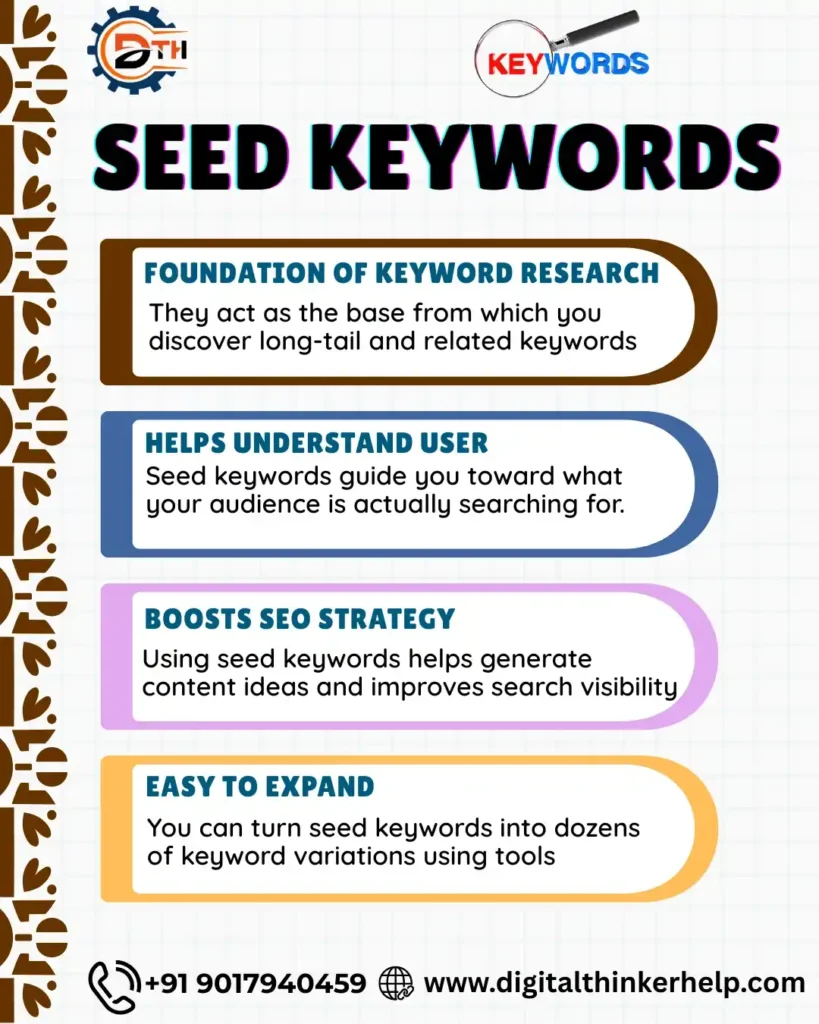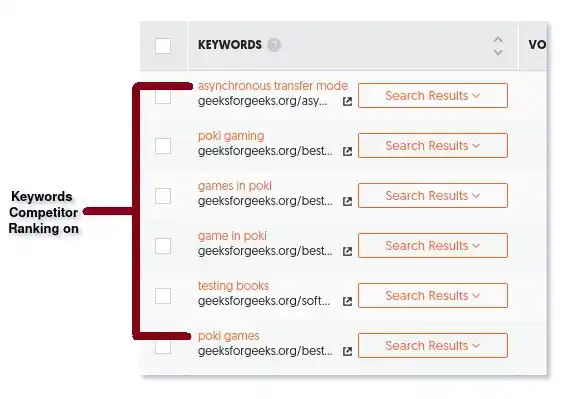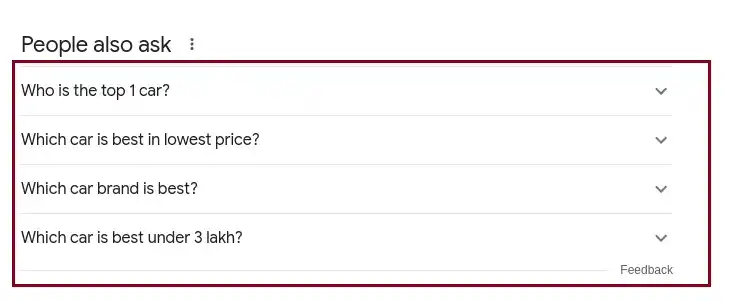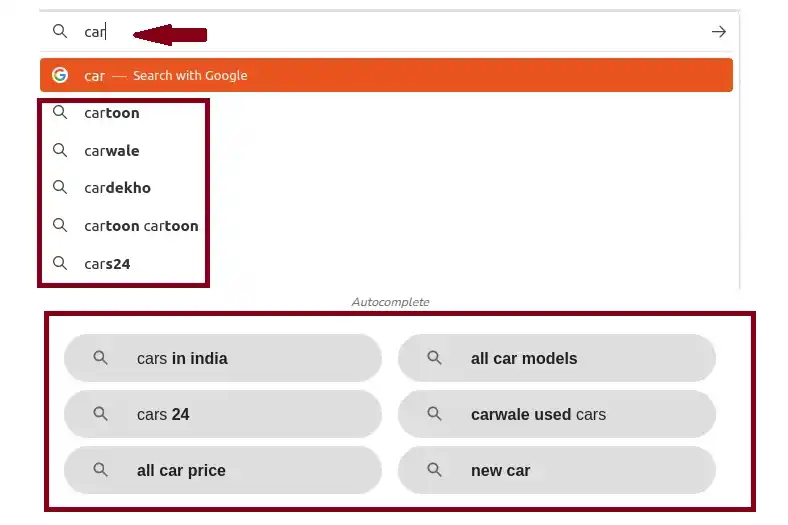If you are ever note a blog or done keyword research, you are already worked with seed keywords even if you did not realize it. These basic keywords are usually the very first things you need when planning or creating content like your website. They act as the foundation that helps you find more specific keywords and build strong SEO strategies.
Finding and developing seed keywords is a important part of any successful keyword research process. A well prepared seed keyword list gives you a solid foundation to build your all content strategy on.

In this article, I’ll explain what seed keywords are and how you capable of find broad, effective seed keywords to build up your SEO strategy.
What are Seed Keywords? Meaning
Seed keywords also called focus or primary keywords are short terms, usually just one or two words that capture the main idea of your website, product, or service.
They act as the starting point like your keyword research and help you develop longer, more specific long tail keywords.
Like example, if you sell vegan beauty products, your seed keywords must be “vegan,” “cosmetics,” or “beauty products.”
Importance of Seed Keyword
Seed keywords help you find the main topics your website or business need to rank like. They guide your SEO aim and play a big important role in creating the type of content you create and publish.
Seed keywords serve as the initial step in the keyword research process. They act as the foundation like finding both short tail and long tail keywords to use on a webpage. When a blogger begins planning a new blog, they normally research broad topics first in order to understand what subjects they must focus on.
These topics are then turned into seed keywords, which capable of be expanded into both short tail and long tail keyword ideas. Sometimes, seed keywords can also function as short tail keywords. Like example, fitness, travel, cooking, and SEO capable of all be used as seed keywords as well as short-tail keywords.
A single seed keyword capable of generate countless short- and long-tail keyword ideas, and it’s common like an entire website’s content strategy to be built around just a few core seed keywords.
Seed Keywords Examples
“Yoga” (for a yoga studio)
“Recipes” (for a food blog)
“Travel” (for a travel agency or blog)
“Fitness” (for a fitness blog or business)
“Internet marketing” (for an internet marketing agency)
The keyword find process starts when a blogger chooses a seed keyword. Based on your strategy, you capable of then expand that seed keyword into different another types of keywords, such as:
Short Tail and Long Tail Keywords
A seed keyword like “yoga” that is able to be expanded into short tail and long tail keywords.
Short tail keywords are broad terms, and like them, you capable of build even must specific long tail variations. Like example:
Short-Tail Keywords:
1. Yoga poses
2. Yoga classes
3. Yoga benefits
4. Yoga retreats
5. Yoga equipment
Long-Tail Keywords:
Best Yoga Asanas like starter
Mental Health Benefits of Yoga
Yoga Retreat target like Relaxation
How to Find the Right Yoga Class for You?
Important yoga equipment like practicing at home
Expand “yoga” into the short tail keyword “yoga poses,” which capable of lead to these long tail keywords:
Easy yoga poses like stress relief at home
Yoga poses alike back pain relief and relaxation
Advanced yoga poses to build strength and balance
Yoga poses alike better posture and stronger core
Best yoga poses like starter to improve flexibility
How to Find Seed Keywords?
There are some things that you must be knowing about this, including:
Brainstorming
Start by brainstorming words or phrases that are close similar to your business or content. Think around what your audience must type into a search engine when searching like information or products like yours. This simple rule helps you build a list of important word that represents the main ideas of your business.

Competitor Analysis
Take a closer look at the keywords your challengers are targeting. Tools like SEMrush and Ahrefs build this easy by show you which keywords are driving traffic to anyone businesses in your industry.

By seeing what works like them, you capable of provide valuable sensitivity and use those keywords as a starting point like creating your own seed keywords. This helps you complete more correctly in the digital space.
People Also Ask
“People Also Ask” (PAA) is a feature you’ll daily see on Google search results. It shows a box filled with questions related to what you originally searched like. These questions come like real, commonly searched queries, building them a helpful source like finding what users want to know around a topic.

When everyone clicks on a question in the “People Also Ask” (PAA) box, it opens up to show a short answer and a link to the root. As users save clicking on different questions, the PAA box keeps adding new, related questions. This feature helps users dig big into a topic and find more information. It also gives content creators a great chance to answer special questions people are already searching like, which capable of improve clear in search results.
Google Auto Complete and Related Searches
Build good use of Google’s built in features especially Auto complete and Similar Searches at the bottom of the results page. As you start typing in the search bar, Google automatically suggests popular search terms, providing you sensitivity into what people commonly look like.
The Similar Searches section also offers additional keyword ideas and helps you better understand user aim. By using these tools, you capable of find more seed keywords and stay up to date with current search trends.

Using these methods in your keyword research provided you a well rounded and effective approach. When you mix your own ideas with challenger analysis, customer feedback, and helpful search engine qualities, you capable of create a strong and full list of seed keywords.
SEO Best Practices for Seed Keyword
1) Use tools like Google Keyword Planner, SEMrush, or Ahrefs to find keywords, questions, and find similar to your important keyword.

2) Know what people wish when they search like your keyword are they view like information, trying to buy reality or searching like a special type of content?
3) Check the top pages that rank like your keyword to look what nature of content they have, how long it is, and what build it helpful.
4) Optimize On-Page Elements
Make sure your important keyword and similar words looks naturally in the title tag.
Use the important keyword in the Meta description so many people click on your result.
Add the keyword in headings (H1, H2) wherever it builds sense.
Use the keyword and its long tail versions inside your content, but save it natural and easy to read.
If possible, involves the keyword in the URL of the page.
5) Improve User Experience
Make sure your website works great on mobile devices.
Use tools like Google Page Speed sense to speed up your page loading time.
Create a clean and easy to use navigation menu so visitors capable of find what they need quickly.
6. Create high-quality, engaging content that provides real value around topics associated with the seed keyword.
6) Create helpful and interesting content that truly benefits your readers and covers topics similar to your seed keyword.
7) Develop Link-building Strategy
Write guest posts for websites in your industry and naturally include your seed keyword.
Contact high authority sites and request backlinks by offering something valuable, like unique data or an attractive info graphic.
8) Optimize Images
Use clear and meaningful file names that include your seed keyword.
Add alt text to your images that naturally uses the seed keyword or its position.
9) Use plan markup so search engines capable of better understand your content.
10) Save track of your website’s show with tools like Google Analytics and adjust your plan build on how users connect and how your keywords rank.
FAQs (Frequently Asked Questions)
How Many Seed Keywords Should You Target?
There’s no exact rule, but it’s a good idea to start with around 5 to 10 seed keywords. You capable of add more or adjust them later using on how well they bring traffic to your site and how relevant they are to your content.
How Many Seed Keywords Do You Need to Start Keyword Research?
Keyword research does not need to be done all at once. You can start with just one main idea or phrase that capable of then lead to new ideas and topics you must not have idea of before.
What are Best Seed Keywords Tools?
Few of the best tools like find seed keywords are Google Keyword Planner, Ahrefs Keywords Explorer, SEMrush Keyword Magic Tool, Moz Keyword Explorer, Ubersuggest, AnswerThePublic, and KeywordTool.io. These tools help you find important search terms, common questions, and similar topics, build up them great like starting your SEO research and planning content.
Final Remarks
Creating many types of keyword strategy begins with finding the right seed keywords. By using your own knowledge, industry experience, competitor research, search data, and customer insights, you capable of find the important topics and phrases that matter most to your audience.
These seed keywords from the base like finding more specific long tail keywords, creating your expertise on a topic, and creating content that draws valuable organic traffic.
Do not let finding seed keywords feel overwhelming. Take your time, stay careful and open minded and you’ll find valuable keyword opportunities.
